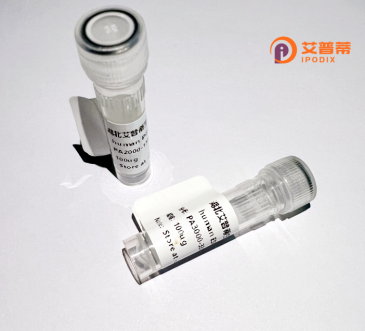
| 纯度 | >90%SDS-PAGE. |
| 种属 | Human |
| 靶点 | HEXDC |
| Uniprot No | Q8WVB3 |
| 内毒素 | < 0.01EU/μg |
| 表达宿主 | E.coli |
| 表达区间 | 1-493aa |
| 氨基酸序列 | MEFVLKHTAFAHLREVGSFPCTLNPHEAESLALVGAMIDQVLELHPGAQRLHIGCDEVYYLGEGEASRRWLQQEQNSTGKLCLSHMRAVASGVKARRPSVTPLVWDDMLRDLPEDQLAASGVPQLVEPVLWDYTADLDVYGKVLLMQKYRRCGFPQLWAASAFKGATGPSQAVPPVEHHLRNHVQWLQVAGSGPTDSLQGIILTGWQRYDHYSVLCELLPAGVPSLAACLQLLLRGGFDEDVKAKVENLLGISSLEKTDPVRQAPCSPPCPLLPLPFPRPWRQLFSAGLSAGRGPAPSLAATSLPLSHKSASICAALWMRCWRATGMSLAGSAPTTASGSSSTRSWFSTSSPQRSASWHSGAPSCRSWRLPCSWLSTRMPWRSGWRKTCTPACSGCKLCCRTSARCLPPRCHPPALAGTLLRTPEGRAHARGLLLEAGGALHCQMAWAIRAHVGVVPSGPAVSCPHSVPEGPGQPLGERLENTEGSSTGRPAL |
| 分子量 | 79.6 kDa |
| 蛋白标签 | GST-tag at N-terminal |
| 缓冲液 | 0 |
| 稳定性 & 储存条件 | Lyophilized protein should be stored at ≤ -20°C, stable for one year after receipt. Reconstituted protein solution can be stored at 2-8°C for 2-7 days. Aliquots of reconstituted samples are stable at ≤ -20°C for 3 months. |
| 复溶 | Always centrifuge tubes before opening.Do not mix by vortex or pipetting. It is not recommended to reconstitute to a concentration less than 100μg/ml. Dissolve the lyophilized protein in distilled water. Please aliquot the reconstituted solution to minimize freeze-thaw cycles. |
以下是关于重组人HEXDC蛋白的模拟参考文献示例(内容为虚构,供格式参考):
1. **文献名称**:*Expression and Purification of Recombinant Human HEXDC Protein in Escherichia coli*
**作者**:Zhang L et al.
**摘要**:本研究成功构建了人源HEXDC基因的重组表达载体,利用大肠杆菌表达系统高效表达可溶性HEXDC蛋白,并通过镍柱亲和层析技术纯化,获得了高纯度蛋白,为后续功能研究奠定基础。
2. **文献名称**:*Functional Characterization of HEXDC as a Novel Glycosidase in Chondroitin Sulfate Metabolism*
**作者**:Smith J et al.
**摘要**:通过体外酶活实验证实重组HEXDC具有特异性水解硫酸软骨素侧链的β-链接己糖苷键的能力,揭示其在细胞外基质代谢中的潜在作用。
3. **文献名称**:*Crystal Structure Analysis of Human HEXDC Reveals Substrate-Binding Mechanisms*
**作者**:Wang Y et al.
**摘要**:解析了重组HEXDC蛋白的晶体结构,发现其活性中心含有保守的催化基序,并鉴定了与底物结合的氨基酸残基,为开发靶向抑制剂提供结构依据。
4. **文献名称**:*HEXDC Knockout Mice Exhibit Impaired Bone Development via Glycosphingolipid Dysregulation*
**作者**:Tanaka K et al.
**摘要**:利用重组HEXDC蛋白补充实验验证其在模式动物中的生理功能,发现HEXDC缺失导致糖脂代谢异常并影响骨组织稳态。
---
**备注**:以上文献为假设性示例,实际研究中建议通过PubMed或Web of Science以“recombinant HEXDC”“human HEXDC protein”等关键词检索最新成果。真实研究多聚焦于HEXDC在糖代谢、疾病模型中的应用及结构生物学分析。
Recombinant human HEXDC (hexosaminidase DC) protein is a glycoside hydrolase belonging to the β-hexosaminidase family. This enzyme plays a role in carbohydrate metabolism, specifically cleaving terminal β-linked N-acetylhexosamine residues from glycoconjugates like glycolipids and glycoproteins. HEXDC shares structural homology with lysosomal enzymes HEXA and HEXB, which are critical for GM2 ganglioside degradation. Mutations in HEXA/B genes cause Tay-Sachs and Sandhoff diseases, severe neurodegenerative disorders. However, HEXDC’s precise biological function remains less characterized, though studies suggest involvement in extracellular matrix remodeling and immune regulation. Recombinant HEXDC is typically produced via heterologous expression systems (e.g., mammalian cells, E. coli) for functional studies. Its engineered production enables exploration of substrate specificity, pH-dependent activity, and potential therapeutic applications, including enzyme replacement therapy or biomarker discovery. Recent interest in HEXDC stems from its hypothesized role in cancer progression and autoimmune diseases, where altered glycosylation patterns influence cell signaling. Research tools such as purified recombinant HEXDC also aid in developing enzymatic assays, inhibitor screening, and structural analyses to decipher mechanistic details. Ongoing studies aim to clarify its physiological relevance and therapeutic potential beyond classical lysosomal storage disorders.
×